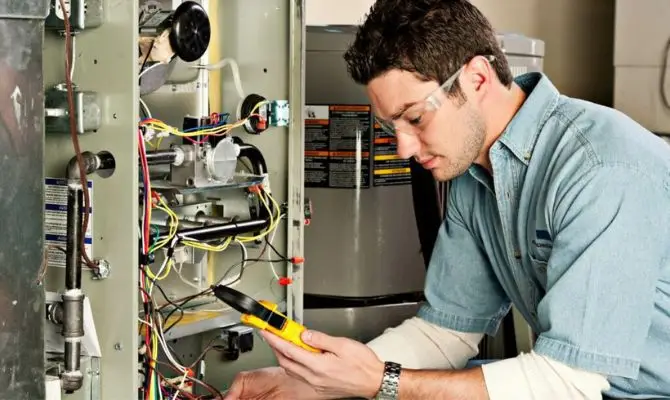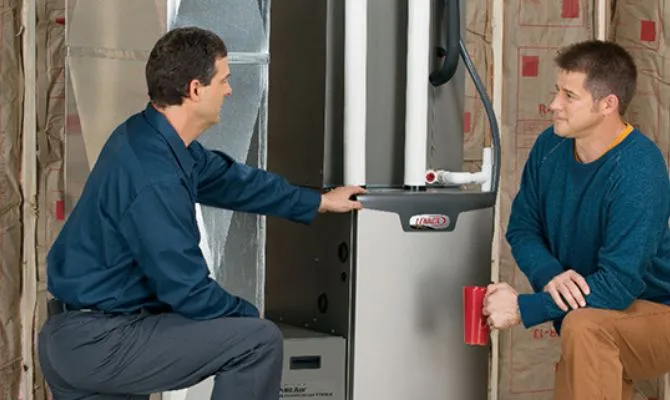The blower in your furnace plays a crucial role in distributing heat or cool air throughout your home. Therefore, if the blower is not functioning properly, your home will not receive any heating or cooling. This can not only make your home uncomfortable, but it can also lead to higher energy bills and potential damage to other parts of your HVAC system.
There are a variety of factors that can prevent a blower from working, including issues with the blower motor itself or problems with other furnace components that prevent the blower motor from running. Some common causes of blower motor failure include:
- A failed capacitor
- A blown fuse or tripped circuit breaker
- A malfunctioning thermostat
- A clogged air filter
- A malfunctioning control board
- A broken belt
Uncovering the Issue: Inspecting the Wires for a Non-Functioning Furnace Fan
Troubleshoot your furnace blower with these simple steps to get your heating system running again.
- Inspect the wires in your furnace to ensure that the power cord hasn’t melted or a fuse hasn’t been blown.
- If the cables appear to be in good condition, try unplugging the fan for a few minutes and then plugging it back in again. This can sometimes reset the motor and resolve the issue.
- If unplugging and plugging the fan back in doesn’t work, check the fuse box for a popped breaker. A surge in electricity may have overloaded the system, causing the breaker to switch off.
- If you find a popped breaker, switch it back on.
By following these troubleshooting steps, you may be able to resolve the issue with your furnace blower and get your heating system running again. If the problem persists, it may be best to call a professional HVAC technician to diagnose and repair the problem.
Thermostat Troubleshooting: Fixing a Non-Functioning Furnace Fan
The next step to troubleshoot a non-functioning furnace fan is to check the thermostat. Make sure that it is set correctly and working properly. Many thermostats come set to “auto” mode from the factory, but it may malfunction, become outdated or set incorrectly. You may need to put it in manual override.
Most thermostats have three settings: “on,” “auto,” and “off.” Try switching the thermostat setting to “on” this will lock the fan into an always-on state, which may not be energy efficient but will solve the problem of the fan not working until a professional inspection and repair can be done. If switching the thermostat control to “on” does not work, try replacing the batteries in the thermostat or setting the temperature controls to 3-5 degrees above the room temperature. If none of these solutions work, it is best to call a furnace repair expert as soon as possible.
When your furnace’s blower won’t turn on, you can also check the fuse or circuit breaker to make sure that it hasn’t been tripped. If it has, simply reset it and see if the blower starts working. If the problem persists, it may be a good idea to check the thermostat to ensure that it is set to the correct temperature and that the batteries are still working.
Efficient Fix: Inspecting the Filters and Vents for a Non-Functioning Furnace Blower
The next step is to check the air filter. If it is clogged with dirt and debris, it can restrict the airflow and cause the blower motor to overheat. Replacing the filter can often solve this problem.
Blower Troubleshooting: Inspecting the Fan Belt for Proper Functioning of the Furnace
If your furnace blower is not working, one possible cause could be a snapped fan belt. Some furnaces, particularly older ones, have belt-driven blowers. If the fan belt snaps, the blower motor will spin, but the fan will not. The main cause of a snapped fan belt is due to wear and tear over time. Even properly installed fan belts eventually wear out, so they are replaceable.
However, if your fan belt wears out prematurely, it may be a sign that it is out of alignment or tension. One telltale sign of a fan belt that’s out of alignment or tension is a squeaking noise when your furnace is running. This squeaking noise is caused by the fan belt slipping over the pulley, which is caused by misalignment or incorrect tension. It is important to address this issue as soon as possible to avoid further damage to the blower and the rest of the furnace.
Humming No More: Troubleshooting a Faulty Capacitor in your Furnace Blower
If your blower motor is making a humming noise and the lights turn on but nothing else happens, the problem may be a faulty capacitor. Blower motors require a lot of power to run and even if your furnace is connected to a 240-volt outlet, it will still need a capacitor to store and discharge the 400+ volts it needs to function. If the blower motor won’t turn on, it could be due to a damaged capacitor. A load that becomes too large can cause the capacitor to break and negatively impact the performance of your furnace.
When a capacitor is damaged, it can cause the hum to sound more like a buzz instead of a clicking or whining noise. Due to the high voltages involved, it is not recommended to do this type of repair yourself and it is best to call a professional HVAC technician to diagnose and repair the problem.
Blower Motor Reboot: A Step-by-Step Guide to Resetting Your Furnace
Resetting your furnace blower motor is a simple process that can help resolve issues with the unit. To begin, turn off the power to the furnace by shutting off the breaker that it connects to. This is important to ensure safety during the process. Next, remove the blower cover. The cover can usually be removed by removing several screws around the front.
Allow the blower to cool down, so that any metal components are safe to touch. Once the blower is cool, locate the reset button, which is usually red and located on the backside of the motor. If the reset button has popped, push it back in. This button connects to a small circuit breaker inside the blower that will pop if it gets overloaded.
After completing these steps, your blower motor should be successfully reset. However, if the red button on the back of the motor hasn’t popped, it’s likely that the motor is bad and it’s best to call a professional to diagnose and repair the problem. It is also important to keep in mind that if the blower motor continues to have issues, it’s best to consult a professional as the issue can be more complex.
Blowing Away the Signs: How to Recognize When it’s Time to Replace Your Furnace Blower
There are several signs that it may be time to replace your furnace blower. The two most common signs are overheating and moisture damage.
- Overheating: If the motor’s electrical and bearing components are constantly exposed to excessive heat, they will begin to fail. This can happen if you don’t prevent overheating by regularly checking your vents, filters, and in-room airflow.
- Moisture Damage: Moisture damage can occur due to humidity, leaks in the ceiling or an incorrectly installed coil. If water gets into the blower motor, it can cause corrosion on the motor casing and control panel, as well as damage to the wires and electrical components. This can lead to short circuits and cause the blower motor to malfunction or stop working altogether. Moisture damage can also lead to the growth of mold and mildew inside the furnace, which can be dangerous for your health and the air quality of your home.
To prevent moisture damage, it is important to keep the area around the furnace dry and well-ventilated. Consider placing a dehumidifier in the utility room to keep the humidity levels low. Also, make sure that any leaks or potential sources of condensation, such as pipes, are located away from the furnace. Regularly checking for signs of moisture damage, such as rust or mold, can also help to prevent further damage to your furnace blower.
In conclusion, when your furnace’s blower won’t turn on, there can be a variety of causes, some of them easy to fix but others are more complicated. It’s important to check the simple causes before calling for a professional, but if the problem persists, it’s best to call a professional HVAC technician to diagnose and repair the problem.



